Because of all that digital marketing involves (SEO, content marketing, analytics, etc.), it can be overwhelming to decide where to start and, most importantly, to choose what will benefit your business the most. That's why, for digital marketing to be effective, you need a strategy that will be triggered by campaigns.
As we discussed earlier, your digital strategy is the series of actions you take that help you achieve your main marketing objective. Well, your digital marketing campaigns are the fundamental elements or actions within your strategy that are applied to achieve that objective.
For example, you could launch a campaign sharing some of your content on Facebook and thus increase your number of leads through that channel. That campaign would be part of your strategy, specifically to generate more leads.
All of this brings us to the heart of the matter: the "unwritten steps" to creating an effective digital marketing strategy are as follows:
Step 1. Identify your Buyer Persona
Buyer personas represent your ideal customers and can be created through research, surveys and interviews with your company's target audience. It is important to keep in mind that, whenever possible, this information should be based on real data, as speculating about your audience can lead your marketing strategy in the wrong direction.
Step 2. Create a Copywriting Manual
This is about writing persuasive copy that engages and converts with a clear objective: to grab the reader's attention with a final purpose. Write to sell.
Step 3. Set SMART objectives
A SMART objective is an acronym that translates into English as: Specific, Measurable, Achievable, Realistic and Time-bound. These are the aspects we must take into account when setting objectives. They are concrete goals that allow us to analyze the performance of our efforts, whether in marketing or in any area of a company that needs to systematically organize and measure its work.
Step 4. Develop personalized and segmented campaigns
It is of utmost importance to attract our customers in a personalized and segmented way, so it is necessary to take into account that it must be: Individually, based on their behavior, continuously over time, focusing on a specific target and wherever they are. Always take advantage of your segmentation.
Step 5. Build a content strategy
The content strategy seeks to impact the audience with clear messages that produce meaningful and interactive experiences. Based on your findings and identified gaps, map out a content creation plan that details what you need to achieve your objectives.
Step 6. Conduct market research
Market research is a tool that provides a preview of the future. Its function is to guide a company's positioning, its most qualified decisions and can highlight the most effective strategies to maintain positive and growing results.
Its purpose is to collect and interpret data and information. With research, you will be able to gain more knowledge about your market niche and target audience. With that, you will be able to get ideas for your business and make more assertive business decisions.
Step 7. Analyze your metrics
Last but not least, we must have an analysis of metrics (analytics). This tool provides information to optimize the site and get to know the user better.
These are the steps we recommend for an effective digital marketing strategy. What else would you add?
.



